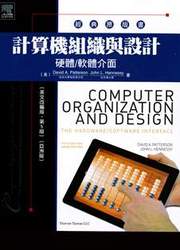買這商品的人也買了...
-
 $2,280Working Effectively with Legacy Code (Paperback)
$2,280Working Effectively with Legacy Code (Paperback) -
 $1,460Introduction to Fourier Optics, 3/e (Hardcover)
$1,460Introduction to Fourier Optics, 3/e (Hardcover) -
 $1,274Chemical Principles: The Quest for Insight, 4/e
$1,274Chemical Principles: The Quest for Insight, 4/e -
 Elementary Linear Algebra with Supplemental Applications, 10/e (Paperback)
Elementary Linear Algebra with Supplemental Applications, 10/e (Paperback)$1,400$1,372 -
 $1,560Physically Based Rendering : From Theory To Implementation, 2/e (Hardcover)
$1,560Physically Based Rendering : From Theory To Implementation, 2/e (Hardcover) -
 你會問問題嗎? ─問對問題是成功領導的第一步, 2/e (Leading with Questions:How Leaders Find the Right Solutions by Knowing What to Ask)
你會問問題嗎? ─問對問題是成功領導的第一步, 2/e (Leading with Questions:How Leaders Find the Right Solutions by Knowing What to Ask)$280$238 -
 Android 4.X 手機/平板電腦程式設計入門、應用到精通, 2/e (適用 Android 1.X~4.X)
Android 4.X 手機/平板電腦程式設計入門、應用到精通, 2/e (適用 Android 1.X~4.X)$520$411 -
打造安全無虞的 Web Applications-從策略制定、程式開發,到防止惡意攻擊之必備對策白皮書
$560$437 -
SQL Server 2012 管理實戰
$750$593 -
實戰雲端作業系統建置與維護-VMware vSphere 5 虛擬化全面啟動
$680$537 -
JavaScript & jQuery: The Missing Manual 國際中文版, 2/e
$580$458 -
 Java 7 教學手冊, 5/e
Java 7 教學手冊, 5/e$650$553 -
 Introduction to Java Programming : Comprehensive Version, 9/e (IE-Paperback)
Introduction to Java Programming : Comprehensive Version, 9/e (IE-Paperback)$1,400$1,372 -
 《超強圖解》前進 App Store!iOS 6 SDK 實戰演練
《超強圖解》前進 App Store!iOS 6 SDK 實戰演練$950$751 -
 HTML5 完美風暴, 2/e
HTML5 完美風暴, 2/e$1,000$700 -
 ASP.NET MVC 4 網站開發美學
ASP.NET MVC 4 網站開發美學$680$537 -
 精實執行-精實創業指南, 2/e (Running Lean: Iterate from Plan A to a Plan That Works, 2/e)
精實執行-精實創業指南, 2/e (Running Lean: Iterate from Plan A to a Plan That Works, 2/e)$450$356 -
 Arduino UNO R3 開發板(副廠相容版)附傳輸線
Arduino UNO R3 開發板(副廠相容版)附傳輸線$400$380 -
 UI is Communication: How to Design Intuitive, User Centered Interfaces by Focusing on Effective Communication (Paperback)
UI is Communication: How to Design Intuitive, User Centered Interfaces by Focusing on Effective Communication (Paperback)$1,750$1,663 -
 $1,782Java Network Programming, 4/e (Paperback)
$1,782Java Network Programming, 4/e (Paperback) -
 Computer Organization and Design: The Hardware/Software Interface, 5/e (Asian Edition)(IE-Paperback)
Computer Organization and Design: The Hardware/Software Interface, 5/e (Asian Edition)(IE-Paperback)$1,650$1,617 -
 超圖解 Arduino 互動設計入門, 2/e
超圖解 Arduino 互動設計入門, 2/e$680$578 -
 這些 Google 幫我做好的事-用 Google 思維重建 10 倍速工作流程
這些 Google 幫我做好的事-用 Google 思維重建 10 倍速工作流程$300$237 -
 物件導向設計模式-可再利用物件導向軟體之要素 (精裝典藏版) (Design Patterns: Elements of Reusable Object-Oriented Software)
物件導向設計模式-可再利用物件導向軟體之要素 (精裝典藏版) (Design Patterns: Elements of Reusable Object-Oriented Software)$550$550 -
 $270用 Python 寫網絡爬蟲 (Web Scraping with Python)
$270用 Python 寫網絡爬蟲 (Web Scraping with Python)
商品描述
This book introduces students with little or no prior programming experience to the art of computational problem solving using Python and various Python libraries, including PyLab. It provides students with skills that will enable them to make productive use of computational techniques, including some of the tools and techniques of "data science" for using computation to model and interpret data. The book is based on an MIT course (which became the most popular course offered through MIT's OpenCourseWare) and was developed for use not only in a conventional classroom but in in a massive open online course (or MOOC) offered by the pioneering MIT--Harvard collaboration edX. Students are introduced to Python and the basics of programming in the context of such computational concepts and techniques as exhaustive enumeration, bisection search, and efficient approximation algorithms. The book does not require knowledge of mathematics beyond high school algebra, but does assume that readers are comfortable with rigorous thinking and not intimidated by mathematical concepts. Although it covers such traditional topics as computational complexity and simple algorithms, the book focuses on a wide range of topics not found in most introductory texts, including information visualization, simulations to model randomness, computational techniques to understand data, and statistical techniques that inform (and misinform) as well as two related but relatively advanced topics: optimization problems and dynamic programming.
Introduction to Computation and Programming Using Python can serve as a stepping-stone to more advanced computer science courses, or as a basic grounding in computational problem solving for students in other disciplines.
商品描述(中文翻譯)
這本書向幾乎沒有程式設計經驗的學生介紹使用 Python 及各種 Python 函式庫(包括 PyLab)進行計算問題解決的藝術。它提供學生能夠有效利用計算技術的技能,包括一些「資料科學」的工具和技術,以使用計算來建模和解釋資料。這本書基於麻省理工學院(MIT)的一門課程(該課程成為 MIT OpenCourseWare 提供的最受歡迎課程),並為不僅在傳統教室中使用而開發,也適用於由先驅性的 MIT-Harvard 合作 edX 提供的大型開放在線課程(MOOC)。學生在這本書中接觸到 Python 及程式設計的基本概念,並在計算概念和技術的背景下學習,例如完全列舉、二分搜尋和有效的近似演算法。這本書不需要超出高中代數的數學知識,但假設讀者對嚴謹的思考感到舒適,並不會被數學概念所嚇倒。雖然它涵蓋了計算複雜度和簡單演算法等傳統主題,但這本書專注於大多數入門教材中找不到的廣泛主題,包括資訊視覺化、模擬隨機性、理解資料的計算技術,以及提供(和誤導)資訊的統計技術,還有兩個相關但相對進階的主題:優化問題和動態規劃。
《使用 Python 的計算與程式設計入門》可以作為更高級計算機科學課程的踏腳石,或作為其他學科學生在計算問題解決方面的基本基礎。














